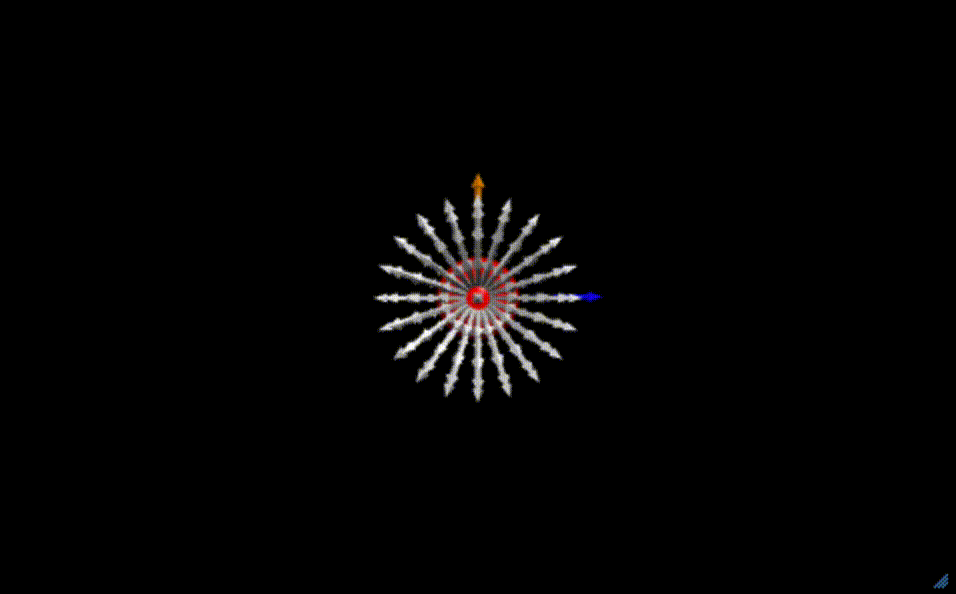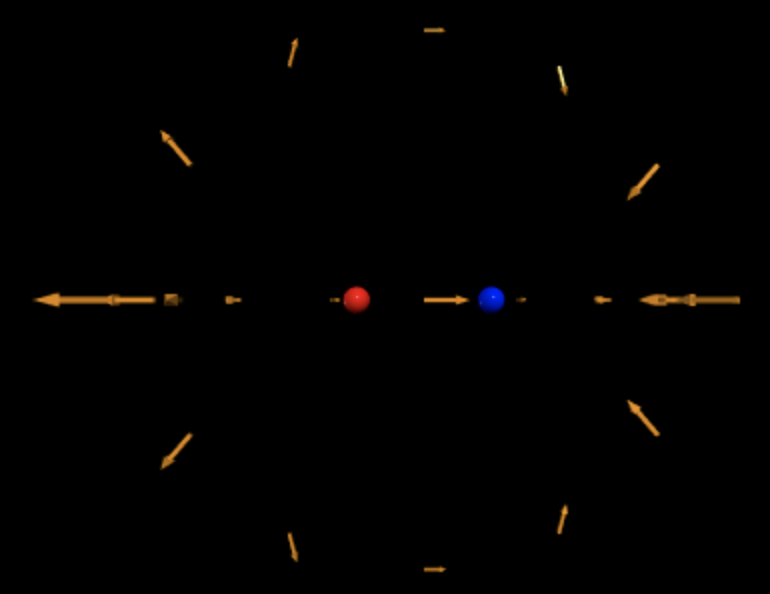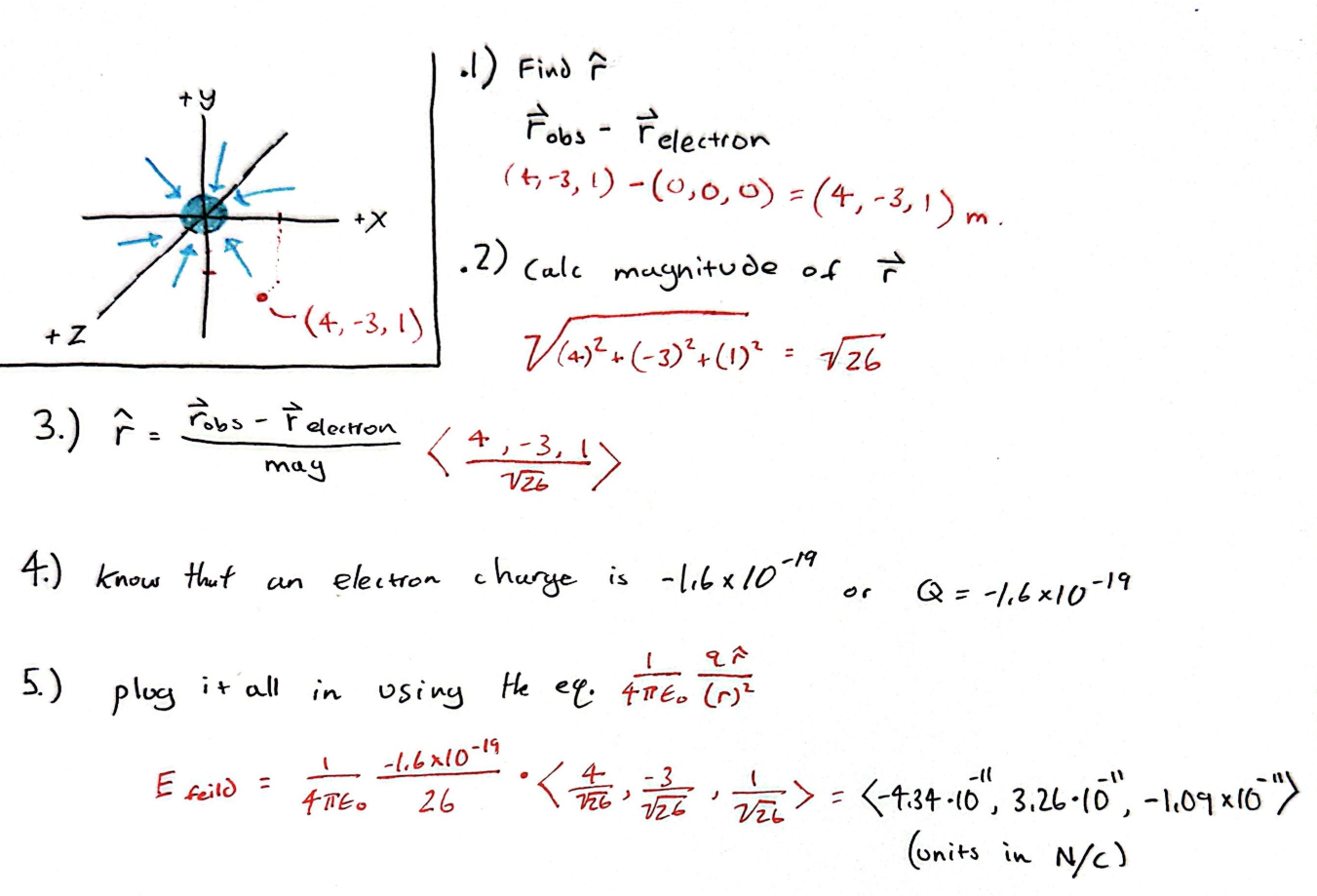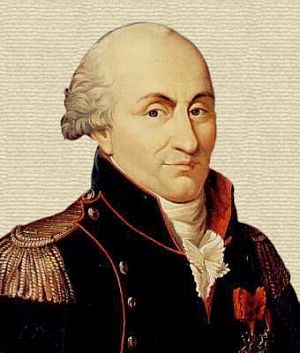Point Charge: Difference between revisions
No edit summary |
No edit summary |
||
| Line 142: | Line 142: | ||
There is an electron at the origin. Calculate the electric field at <4, -3, 1> m. | There is an electron at the origin. Calculate the electric field at <4, -3, 1> m. | ||
[[File:Screenshot_2024-04-13_160839.png]] | |||
===Middling=== | ===Middling=== | ||
Revision as of 16:39, 13 April 2024
Claimed by Machayla Randall Fall 2023
This page is all about the Electric Field due to a Point Charge.
The Main Ideas
(Ch 13.1 in Matter & Interactions Vol. 2: Modern Mechanics, 4th Edition by R. Chabay & B. Sherwood)
Point Charge/Particle - an object with a radius that is very small compared to the distance between it and any other objects of interest in the system. Since it is very small, the object can be treated as if all of its charge and mass are concentrated at a single "point".
- Electrons and Protons are always considered to be point particles unless stated otherwise
2 types of point charges:
- Protons (e) --> positive point charges, ( q = 1.6e-19 Coulombs)
- Electrons (-e) --> negative point charges, (q = -1.6e-19 Coulombs)
Like point charges attract, opposite point charges repel.
ex.
| Point Charges | Result | Diagram |
|---|---|---|
| 1 proton, 1 electron | Attract | 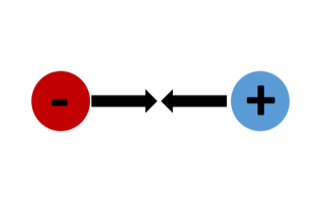 |
| 2 protons | Repel | 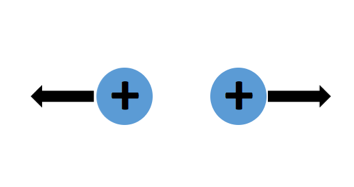 |
| 2 electrons | Repel | 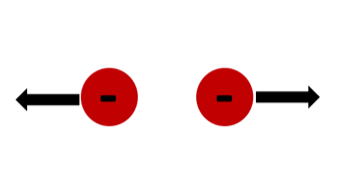 |
The Electric Field
(Ch 13.3 in Matter & Interactions Vol. 2: Modern Mechanics, 4th Edition by R. Chabay & B. Sherwood)
In general, the electric field evaluates the affect of the source on the surrounding objects and area. The electric field created by a charge is present throughout space at all times, whether or not there is another charge around to feel its effects. Therefore, the concept of the electric field by a point charge describes the interactions that can happen at a distance, due to these affects caused by this point charge.
Important to differentiate that Electric Force does not equal the Electric Field.
Electric Field of a Charge Observed at a location: F = Eq
- F = Force on particle
- E = electric field at source location
- q = magnitude of the charge of particle (assume q= 1.6 x 10^-19 unless stated otherewise)
The magnitude of the electric field decreases with increasing distance from the point charge.
| The electric field of a positive point charge points radially outward | The electric field of a negative point charge points radially inward |
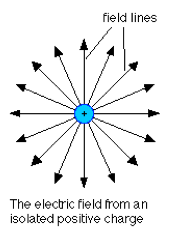 |
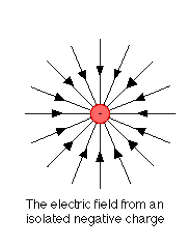 |
A Mathematical Model
Electric Field due to Point Charge
(Ch 13.4 in Matter & Interactions Vol. 2: Modern Mechanics, 4th Edition by R. Chabay & B. Sherwood)
The magnitude of the electric field decreases with increasing distance from the point charge. This is described by the equation below:
Electric Field of a Point Charge ([math]\displaystyle{ \vec E }[/math]):
[math]\displaystyle{ \vec E=\frac{1}{4 \pi \epsilon_0 } \frac{q}{\mid\vec r\mid ^2} \hat r }[/math] (Newtons/Coulomb)
- [math]\displaystyle{ \frac{1}{4 \pi \epsilon_0 } }[/math] is Coulomb's Constant and is approximately [math]\displaystyle{ 8.987*10^{9}\frac{N m^2}{C^2} }[/math]
- q is the charge of the particle
- r is the magnitude of the distance between the observation location and the source location
- [math]\displaystyle{ \hat r }[/math] is the unit vector in the direction of the distance from the source location to the observation point.
The direction of the electric field at the observation location depends on the both the direction of [math]\displaystyle{ \hat r }[/math] and the sign of the source charge.
- If the source charge is positive, the field points away from the source charge, in the same direction as [math]\displaystyle{ \hat r }[/math].
- If the source charge is negative, the field points toward the source charge, in the opposite direction as [math]\displaystyle{ \hat r }[/math].
Coulomb Force Law for Point Charges
(Ch 13.2 in Matter & Interactions Vol. 2: Modern Mechanics, 4th Edition by R. Chabay & B. Sherwood)
[math]\displaystyle{ \mid\vec F\mid=\frac{1}{4 \pi \epsilon_0 } \frac{\mid Q_1Q_2 \mid}{r^2} }[/math]
Coulomb's law is one of the four fundamental physical interactions, and it describes the magnitude of the electric force between two point-charges.
- [math]\displaystyle{ Q_1, Q_2 }[/math]= The charges of the two particles of interest
- [math]\displaystyle{ \mid\vec F\mid=\frac{1}{4 \pi \epsilon_0 } }[/math] = constant,
- [math]\displaystyle{ Q_1, Q_2 }[/math] = the magnitudes of the point charges
- r = The distance between the two particles
Connection Between Electric Field and Force
The force on a source charge is determined by [math]\displaystyle{ F = Eq }[/math] where E is the electric field and q is the charge of a test charge in Coulombs.
By solving for the electric field in [math]\displaystyle{ F = Eq }[/math], with F modeled by Coulomb's Law, you get the equation for the electric field of the point charge:
[math]\displaystyle{ E = \frac{F}{q_2} = \frac{1}{4 \pi \epsilon_0 } \frac{q_1q_2}{r^2}\frac{1}{q_2}\hat r = \frac{1}{4 \pi \epsilon_0 } \frac{q_1}{r^2} \hat r }[/math]
The direction of electric force also depends on the direction of the electric field too:
- If the source charge is positive, the field points away from the source charge, in the same direction as the electric force.
- If the source charge is negative, the field points toward the source charge, in the opposite direction as the electric force.
Electric Field Superposition (Point Charges)
When there are multiple point charges present, the total net electric field [math]\displaystyle{ Enet }[/math], is equal to the sum of the electric field of each independent point charge present.
This is due to concept of Superposition which is when the total effect is the sum of the effects of each part.
When it comes to the Electric Field Superposition of Point Charges, be sure to remember that:
- A charge cannot exert a force on itself
- Assume that the source charges do not move. (Therefore [math]\displaystyle{ Fnet = 0 }[/math])
A Computational Model
Below is a link to a code which can help visualize the Electric Field at various observation locations due to a proton. Notice how the arrows decrease in size by a factor of [math]\displaystyle{ \frac{1}{r^{2}} }[/math] as the observation location gets farther from the proton. The magnitude of the electric field decreases as the distance to the observation location increases.
Two adjacent point charges of opposite sign exhibit an electric field pattern that is characteristic of a dipole. This interaction is displayed in the code below. Notice how the electric field points towards the negatively charged point charge (blue) and away from the positively charged point charge (red).
Examples
Simple
There is an electron at the origin. Calculate the electric field at <4, -3, 1> m.
Middling
A particle of unknown charge is located at <-0.21, 0.02, 0.11> m. Its electric field at point <-0.02, 0.31, 0.28> m is [math]\displaystyle{ \lt 0.124, 0.188, 0.109\gt }[/math] N/C. Find the magnitude and sign of the particle's charge.
Given both an observation location and a source location, one can find both r and [math]\displaystyle{ \hat{r} }[/math] Given the value of the electric field, one can also find the magnitude of the electric field. Then, using the equation for the magnitude of electric field of a point charge, [math]\displaystyle{ E_{mag}= \frac{1}{4 \pi \epsilon_0 } \frac{q}{r^2} }[/math] one can find the magnitude and sign of the charge.
| Step 1. Find [math]\displaystyle{ \vec r_{obs} - \vec r_{particle} }[/math]:
[math]\displaystyle{ \vec r = \lt -0.02, 0.31, 0.28\gt m - \lt -0.21, 0.02, 0.11\gt m = \lt 0.19,0.29,0.17\gt m }[/math] To find [math]\displaystyle{ \vec r_{mag} }[/math], find the magnitude of [math]\displaystyle{ \lt 0.19,0.29,0.17\gt }[/math] [math]\displaystyle{ \sqrt{0.19^2+0.29^2+0.17^2}=\sqrt{0.1491}= 0.39 }[/math] |
| Step 2: Find the magnitude of the Electric Field:
[math]\displaystyle{ E= \lt 0.124, 0.188, 0.109\gt N/C }[/math] [math]\displaystyle{ E_{mag} = (\sqrt{0.124^2+0.188^2+0.109^2}=\sqrt{0.0626}=0.25 }[/math] |
| Step 3: Find q by rearranging the equation for [math]\displaystyle{ E_{mag} }[/math]
[math]\displaystyle{ E_{mag}= \frac{1}{4 \pi \epsilon_0 } \frac{q}{r^2} }[/math] By rearranging this equation we get [math]\displaystyle{ q= {4 \pi * \epsilon_0 } *{r^2}*E_{mag} }[/math] [math]\displaystyle{ q= {1/(9*10^9)} *{0.39^2}*0.25 }[/math] [math]\displaystyle{ q= + 4.3*10^{-12} C }[/math] |
Difficult
The electric force on a -2mC particle at a location (3.98 , 3.98 , 3.98) m due to a particle at the origin is [math]\displaystyle{ \lt -5.5*10^{3} , -5.5*10^{3}, -5.5*10^{3}\gt }[/math] N. What is the charge on the particle at the origin?
Given the force and charge on the particle, one can calculate the surrounding electric field. With this variable found, this problem becomes much like the last one. [math]\displaystyle{ E_{mag}= \frac{1}{4 \pi \epsilon_0 } \frac{q}{r_{mag}^2} }[/math] to find the rmag value. To find [math]\displaystyle{ \hat r }[/math] we can find the direction of the electric field as that is obviously going to be in the same direction as [math]\displaystyle{ \hat r }[/math]. Then, once we find [math]\displaystyle{ \hat r }[/math], all that is left to do is multiply [math]\displaystyle{ \hat r }[/math] by rmag and that will give us the [math]\displaystyle{ r }[/math] vector. We can then find the location of the particle as we know [math]\displaystyle{ r=r_{observation}-r_{particle} }[/math]
| Step 1. Find the magnitude of the Electric field:
[math]\displaystyle{ F = Eq }[/math] [math]\displaystyle{ = E * -2mC }[/math] [math]\displaystyle{ E = \frac{\lt -5.5e3 , -5.5e3, -5.5e3\gt }{-2mC} = \lt 2.75e6 , 2.75e6, 2.75e6\gt }[/math] N/C |
| Step 2: Find [math]\displaystyle{ \vec r_{obs} - \vec r_{particle} }[/math].
[math]\displaystyle{ \vec r = \lt 3.98 , 3.98 , 3.98\gt m - \lt 0 , 0 , 0\gt m = \lt 3.98 , 3.98 , 3.98\gt m }[/math] To find [math]\displaystyle{ \vec r_{mag} }[/math], find the magnitude of [math]\displaystyle{ \lt 3.98 , 3.98 , 3.98\gt }[/math] [math]\displaystyle{ \sqrt{3.98^2+3.98^2+3.98^2}=\sqrt{47.52}= 6.9 }[/math] |
| Step 3: Find q by rearranging the equation for [math]\displaystyle{ E_{mag} }[/math]
[math]\displaystyle{ E_{mag}= \frac{1}{4 \pi \epsilon_0 } \frac{q}{r^2} }[/math] By rearranging this equation we get [math]\displaystyle{ q= {4 pi * \epsilon_0 } *{r^2}*E_{mag} }[/math] [math]\displaystyle{ q= {{1/(9e9)} *{6.9^{2}}*4.76e6} }[/math] [math]\displaystyle{ q= + 0.253 C }[/math] |
Connectedness
1. How is this topic connected to something that you are interested in?
I think the topic is interesting because electric fields are inside the human body and we self-create these fields constantly. It's really cool to think about how your body might be responding and creating these fields continuously and what happens when the balances are thrown off by something (i.e. illness, injury).
2. How is it connected to your major?
I'm a biochemistry major and I am also I'm pre-med, so on a molecular level, understanding how these electric fields affect the behavior of cells is extremely interesting. If this behavior can be quantified and applied at a biological level, then huge advancements in medicine and illness treatment can be made. Specifically my area of interest are pharmaceuticals, so understanding how to manipulate these biological electric fields can lead to a new strand of drugs which can essentially target specific illness, diseases, outcomes, etc.
3. Is there an interesting industrial application?
PEMF stands for pulsed electricmagnetic field, which is used by athletes during recovery or physical therapy. There is a difference in cell voltage between healthy cells and diseased cells. While healthy cells maintain a voltage around 70-100 mV, cells with illness have diminished voltage around 40mV. PEMF restores that optimal voltage in damaged cells. Through the utilization of low frequency pulsed electromagnetic fields at a high intensity, voltage in the damaged cells is increased. This stimulates cellular repair and recharges the body’s cells to optimize their performance.
PEMF therapy creates a magnetic field, which increases the movement of ions and electrolytes in the tissues and fluids of the body. The magnetic field helps cells increase ATP production, which restores and / or maintains normal cellular function, speeding up the tissues healing process, repairing damaged tissue, improving circulation, and increasing cellular energy.
History
Charles de Coulomb was born in June 14, 1736 in central France. He spent much of his early life in the military and was placed in regions throughout the world. He only began to do scientific experiments out of curiously on his military expeditions. However, when controversy arrived with him and the French bureaucracy coupled with the French Revolution, Coulomb had to leave France and thus really began his scientific career.
Between 1785 and 1791, de Coulomb wrote several key papers centered around multiple relations of electricity and magnetism. This helped him develop the principle known as Coulomb's Law, which confirmed that the force between two electrical charges is directly proportional to the product of the charges and inversely proportional to the square of the distance between them. This is the same relationship that is seen in the electric field equation of a point charge.
See also
Electric Field
Electric Force
Superposition Principle
Electric Dipole
Further reading
Principles of Electrodynamics by Melvin Schwartz ISBN: 9780486134673
Electricity and Magnetism: Edition 3 , Edward M. Purcell David J. Morin
External links
Some more information:
- http://www.physics.umd.edu/courses/Phys260/agashe/S10/notes/lecture18.pdf
- https://www.reliantphysicaltherapy.com/services/pulsed-electromagnetic-field-pemf
- https://www.youtube.com/watch?v=HG9KxDZ-qwI&t=1s
- https://www.youtube.com/watch?v=8GJf-Fj-qoI&t=3s
References
Chabay. (2000-2018). Matter & Interactions (4th ed.). John Wiley & Sons.
PY106 Notes. (n.d.). Retrieved November 27, 2016, from http://physics.bu.edu/~duffy/py106.html
Retrieved November 28, 2016, from http://www.biography.com/people/charles-de-coulomb-9259075#controversy-and-absolution

